International Marketing Case Study of Porsche in UK and USA Markets
VerifiedAdded on 2023/01/18
|15
|4940
|77
Case Study
AI Summary
This case study examines Porsche's international marketing strategies, focusing on its operations in the UK and US markets. The analysis delves into the market environments of both countries, highlighting key challenges such as competition, consumer awareness, and ethical considerations. The study applies marketing theories like the marketing mix, market segmentation, and industry lifecycle to evaluate Porsche's approach. The challenges include ineffective promotion in the US, ethical concerns in the UK, and the need for innovation in both markets. The paper also explores the impact of consumer behavior and the importance of adapting to local market needs. Ultimately, the study provides a comprehensive overview of Porsche's international marketing strategies and the factors influencing its success in different global markets.
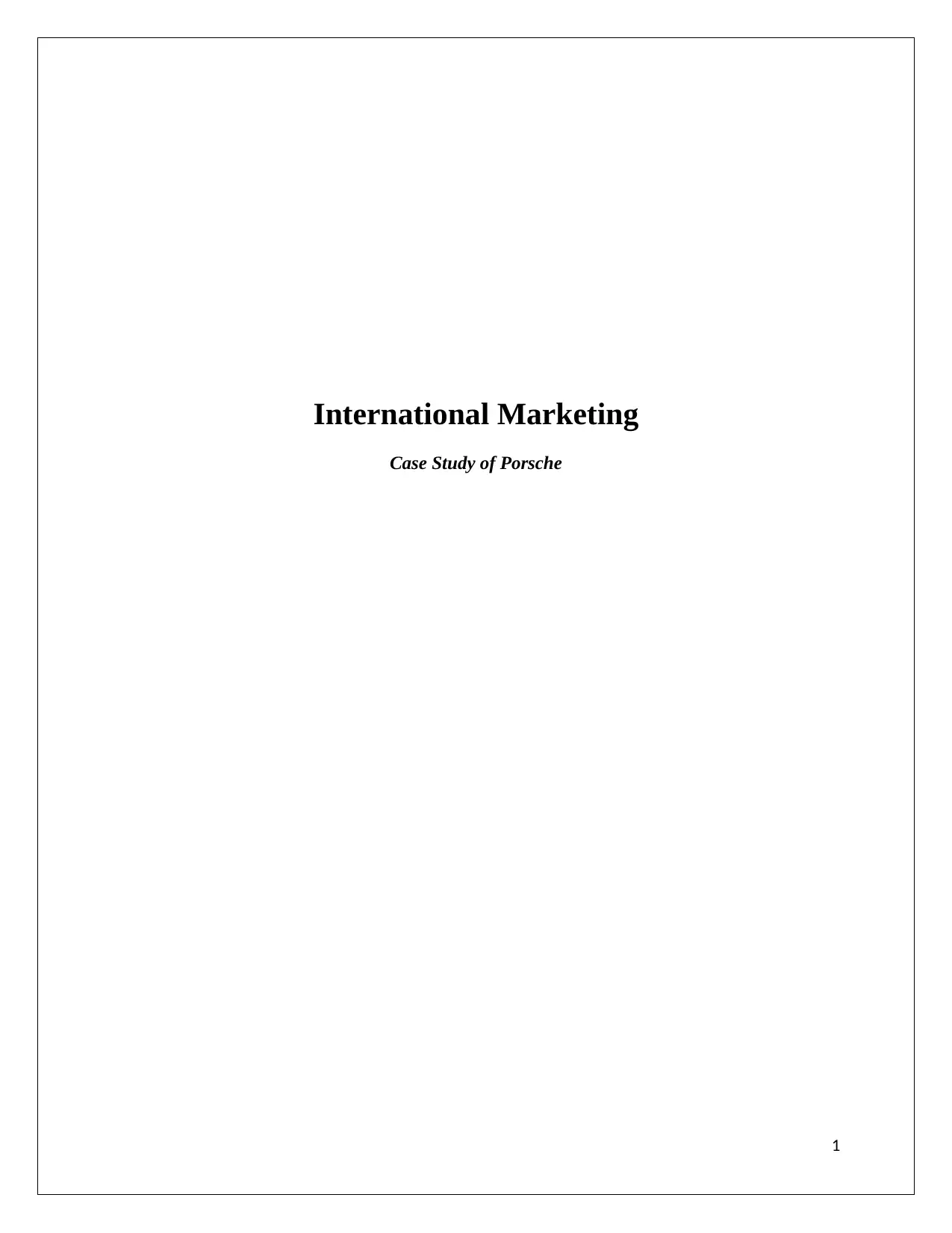
International Marketing
Case Study of Porsche
1
Case Study of Porsche
1
Paraphrase This Document
Need a fresh take? Get an instant paraphrase of this document with our AI Paraphraser
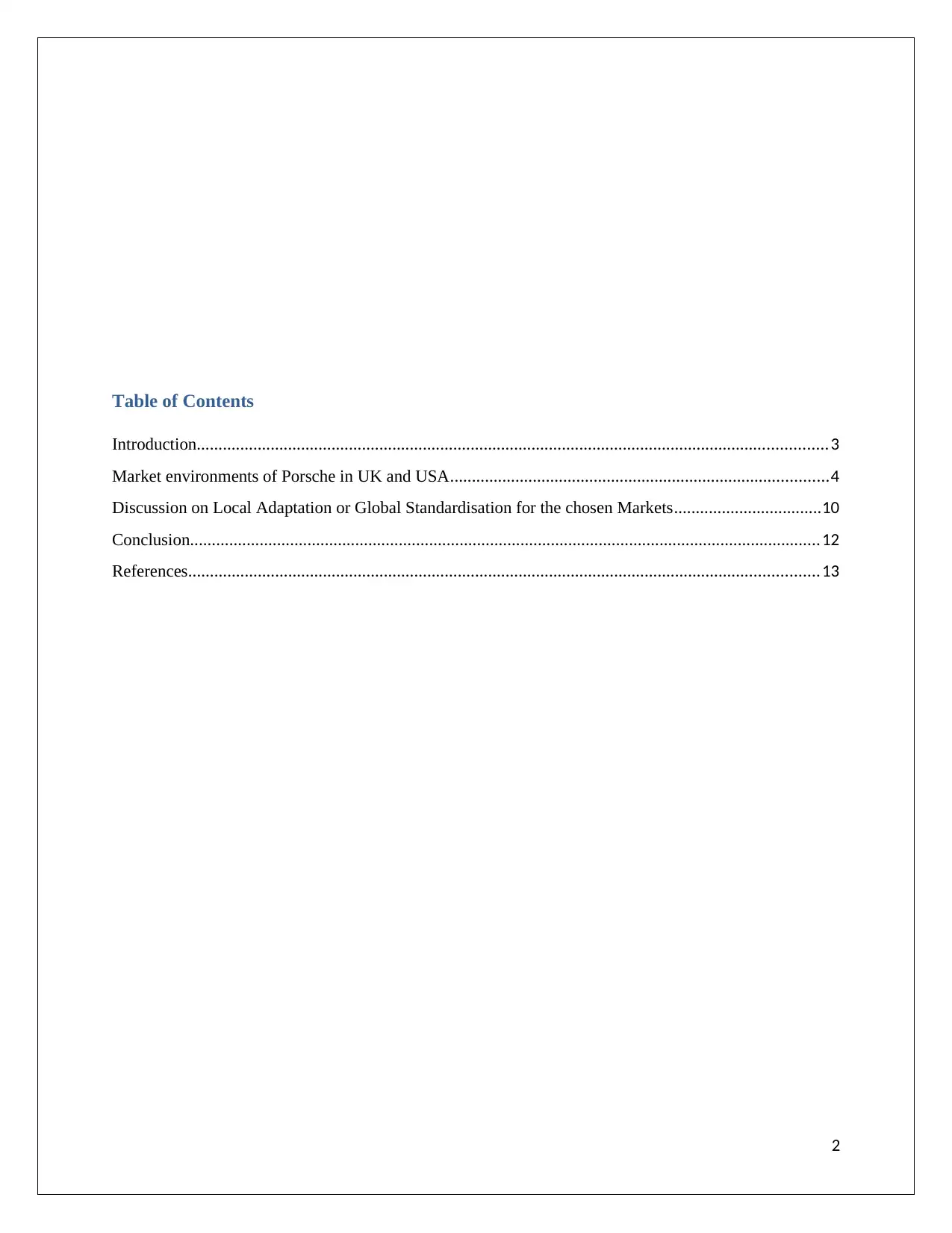
Table of Contents
Introduction.................................................................................................................................................3
Market environments of Porsche in UK and USA.......................................................................................4
Discussion on Local Adaptation or Global Standardisation for the chosen Markets..................................10
Conclusion.................................................................................................................................................12
References.................................................................................................................................................13
2
Introduction.................................................................................................................................................3
Market environments of Porsche in UK and USA.......................................................................................4
Discussion on Local Adaptation or Global Standardisation for the chosen Markets..................................10
Conclusion.................................................................................................................................................12
References.................................................................................................................................................13
2
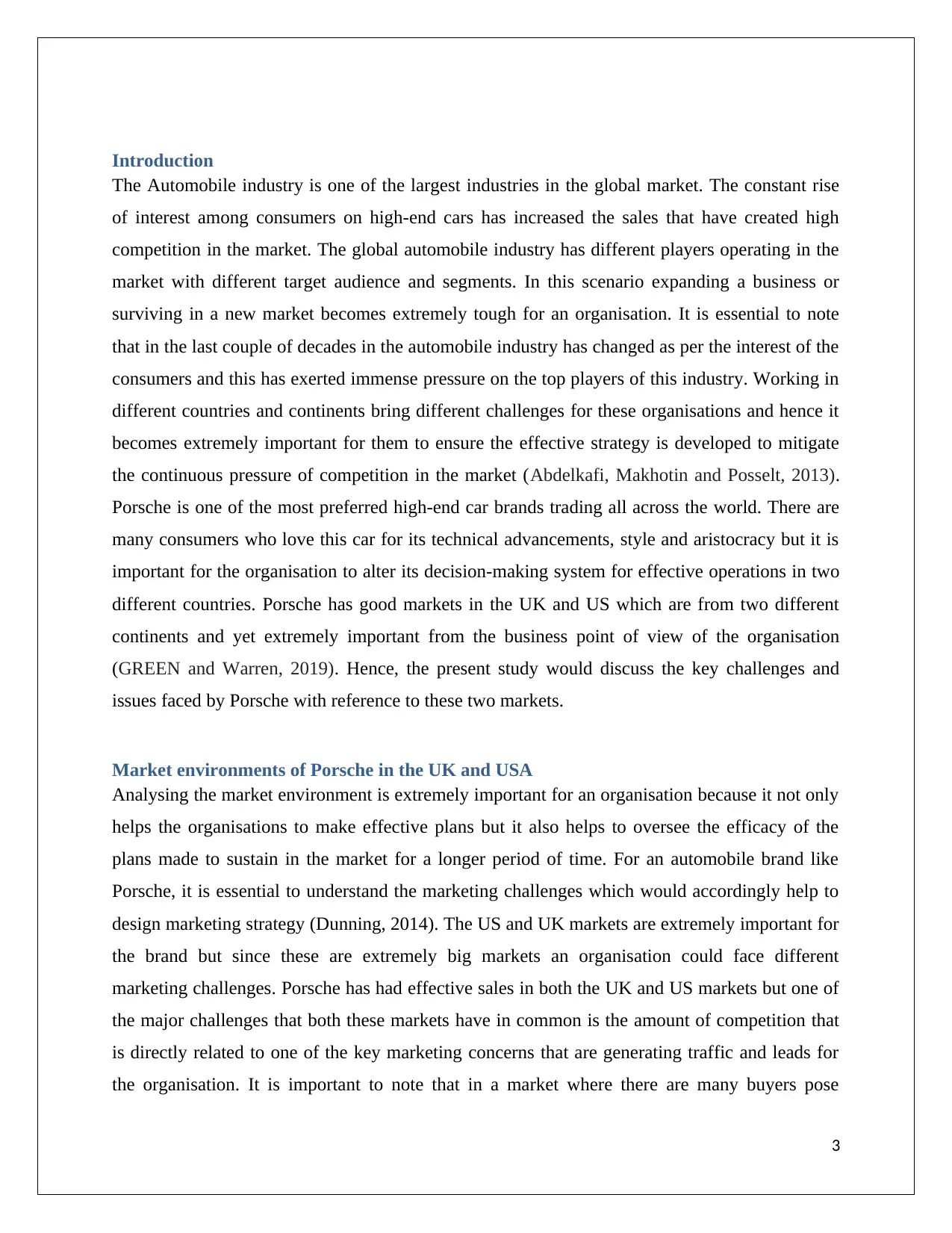
Introduction
The Automobile industry is one of the largest industries in the global market. The constant rise
of interest among consumers on high-end cars has increased the sales that have created high
competition in the market. The global automobile industry has different players operating in the
market with different target audience and segments. In this scenario expanding a business or
surviving in a new market becomes extremely tough for an organisation. It is essential to note
that in the last couple of decades in the automobile industry has changed as per the interest of the
consumers and this has exerted immense pressure on the top players of this industry. Working in
different countries and continents bring different challenges for these organisations and hence it
becomes extremely important for them to ensure the effective strategy is developed to mitigate
the continuous pressure of competition in the market (Abdelkafi, Makhotin and Posselt, 2013).
Porsche is one of the most preferred high-end car brands trading all across the world. There are
many consumers who love this car for its technical advancements, style and aristocracy but it is
important for the organisation to alter its decision-making system for effective operations in two
different countries. Porsche has good markets in the UK and US which are from two different
continents and yet extremely important from the business point of view of the organisation
(GREEN and Warren, 2019). Hence, the present study would discuss the key challenges and
issues faced by Porsche with reference to these two markets.
Market environments of Porsche in the UK and USA
Analysing the market environment is extremely important for an organisation because it not only
helps the organisations to make effective plans but it also helps to oversee the efficacy of the
plans made to sustain in the market for a longer period of time. For an automobile brand like
Porsche, it is essential to understand the marketing challenges which would accordingly help to
design marketing strategy (Dunning, 2014). The US and UK markets are extremely important for
the brand but since these are extremely big markets an organisation could face different
marketing challenges. Porsche has had effective sales in both the UK and US markets but one of
the major challenges that both these markets have in common is the amount of competition that
is directly related to one of the key marketing concerns that are generating traffic and leads for
the organisation. It is important to note that in a market where there are many buyers pose
3
The Automobile industry is one of the largest industries in the global market. The constant rise
of interest among consumers on high-end cars has increased the sales that have created high
competition in the market. The global automobile industry has different players operating in the
market with different target audience and segments. In this scenario expanding a business or
surviving in a new market becomes extremely tough for an organisation. It is essential to note
that in the last couple of decades in the automobile industry has changed as per the interest of the
consumers and this has exerted immense pressure on the top players of this industry. Working in
different countries and continents bring different challenges for these organisations and hence it
becomes extremely important for them to ensure the effective strategy is developed to mitigate
the continuous pressure of competition in the market (Abdelkafi, Makhotin and Posselt, 2013).
Porsche is one of the most preferred high-end car brands trading all across the world. There are
many consumers who love this car for its technical advancements, style and aristocracy but it is
important for the organisation to alter its decision-making system for effective operations in two
different countries. Porsche has good markets in the UK and US which are from two different
continents and yet extremely important from the business point of view of the organisation
(GREEN and Warren, 2019). Hence, the present study would discuss the key challenges and
issues faced by Porsche with reference to these two markets.
Market environments of Porsche in the UK and USA
Analysing the market environment is extremely important for an organisation because it not only
helps the organisations to make effective plans but it also helps to oversee the efficacy of the
plans made to sustain in the market for a longer period of time. For an automobile brand like
Porsche, it is essential to understand the marketing challenges which would accordingly help to
design marketing strategy (Dunning, 2014). The US and UK markets are extremely important for
the brand but since these are extremely big markets an organisation could face different
marketing challenges. Porsche has had effective sales in both the UK and US markets but one of
the major challenges that both these markets have in common is the amount of competition that
is directly related to one of the key marketing concerns that are generating traffic and leads for
the organisation. It is important to note that in a market where there are many buyers pose
3
⊘ This is a preview!⊘
Do you want full access?
Subscribe today to unlock all pages.

Trusted by 1+ million students worldwide
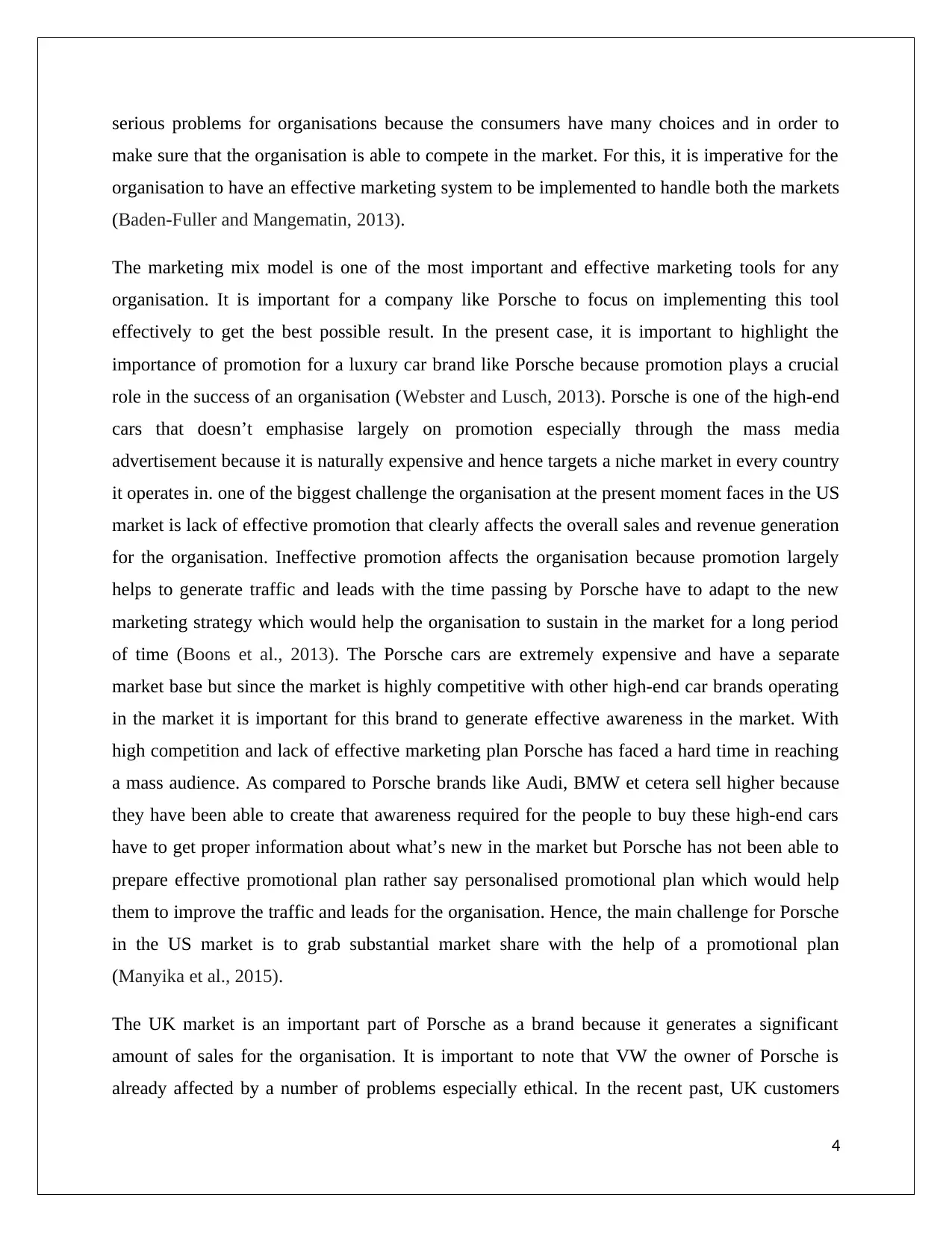
serious problems for organisations because the consumers have many choices and in order to
make sure that the organisation is able to compete in the market. For this, it is imperative for the
organisation to have an effective marketing system to be implemented to handle both the markets
(Baden-Fuller and Mangematin, 2013).
The marketing mix model is one of the most important and effective marketing tools for any
organisation. It is important for a company like Porsche to focus on implementing this tool
effectively to get the best possible result. In the present case, it is important to highlight the
importance of promotion for a luxury car brand like Porsche because promotion plays a crucial
role in the success of an organisation (Webster and Lusch, 2013). Porsche is one of the high-end
cars that doesn’t emphasise largely on promotion especially through the mass media
advertisement because it is naturally expensive and hence targets a niche market in every country
it operates in. one of the biggest challenge the organisation at the present moment faces in the US
market is lack of effective promotion that clearly affects the overall sales and revenue generation
for the organisation. Ineffective promotion affects the organisation because promotion largely
helps to generate traffic and leads with the time passing by Porsche have to adapt to the new
marketing strategy which would help the organisation to sustain in the market for a long period
of time (Boons et al., 2013). The Porsche cars are extremely expensive and have a separate
market base but since the market is highly competitive with other high-end car brands operating
in the market it is important for this brand to generate effective awareness in the market. With
high competition and lack of effective marketing plan Porsche has faced a hard time in reaching
a mass audience. As compared to Porsche brands like Audi, BMW et cetera sell higher because
they have been able to create that awareness required for the people to buy these high-end cars
have to get proper information about what’s new in the market but Porsche has not been able to
prepare effective promotional plan rather say personalised promotional plan which would help
them to improve the traffic and leads for the organisation. Hence, the main challenge for Porsche
in the US market is to grab substantial market share with the help of a promotional plan
(Manyika et al., 2015).
The UK market is an important part of Porsche as a brand because it generates a significant
amount of sales for the organisation. It is important to note that VW the owner of Porsche is
already affected by a number of problems especially ethical. In the recent past, UK customers
4
make sure that the organisation is able to compete in the market. For this, it is imperative for the
organisation to have an effective marketing system to be implemented to handle both the markets
(Baden-Fuller and Mangematin, 2013).
The marketing mix model is one of the most important and effective marketing tools for any
organisation. It is important for a company like Porsche to focus on implementing this tool
effectively to get the best possible result. In the present case, it is important to highlight the
importance of promotion for a luxury car brand like Porsche because promotion plays a crucial
role in the success of an organisation (Webster and Lusch, 2013). Porsche is one of the high-end
cars that doesn’t emphasise largely on promotion especially through the mass media
advertisement because it is naturally expensive and hence targets a niche market in every country
it operates in. one of the biggest challenge the organisation at the present moment faces in the US
market is lack of effective promotion that clearly affects the overall sales and revenue generation
for the organisation. Ineffective promotion affects the organisation because promotion largely
helps to generate traffic and leads with the time passing by Porsche have to adapt to the new
marketing strategy which would help the organisation to sustain in the market for a long period
of time (Boons et al., 2013). The Porsche cars are extremely expensive and have a separate
market base but since the market is highly competitive with other high-end car brands operating
in the market it is important for this brand to generate effective awareness in the market. With
high competition and lack of effective marketing plan Porsche has faced a hard time in reaching
a mass audience. As compared to Porsche brands like Audi, BMW et cetera sell higher because
they have been able to create that awareness required for the people to buy these high-end cars
have to get proper information about what’s new in the market but Porsche has not been able to
prepare effective promotional plan rather say personalised promotional plan which would help
them to improve the traffic and leads for the organisation. Hence, the main challenge for Porsche
in the US market is to grab substantial market share with the help of a promotional plan
(Manyika et al., 2015).
The UK market is an important part of Porsche as a brand because it generates a significant
amount of sales for the organisation. It is important to note that VW the owner of Porsche is
already affected by a number of problems especially ethical. In the recent past, UK customers
4
Paraphrase This Document
Need a fresh take? Get an instant paraphrase of this document with our AI Paraphraser
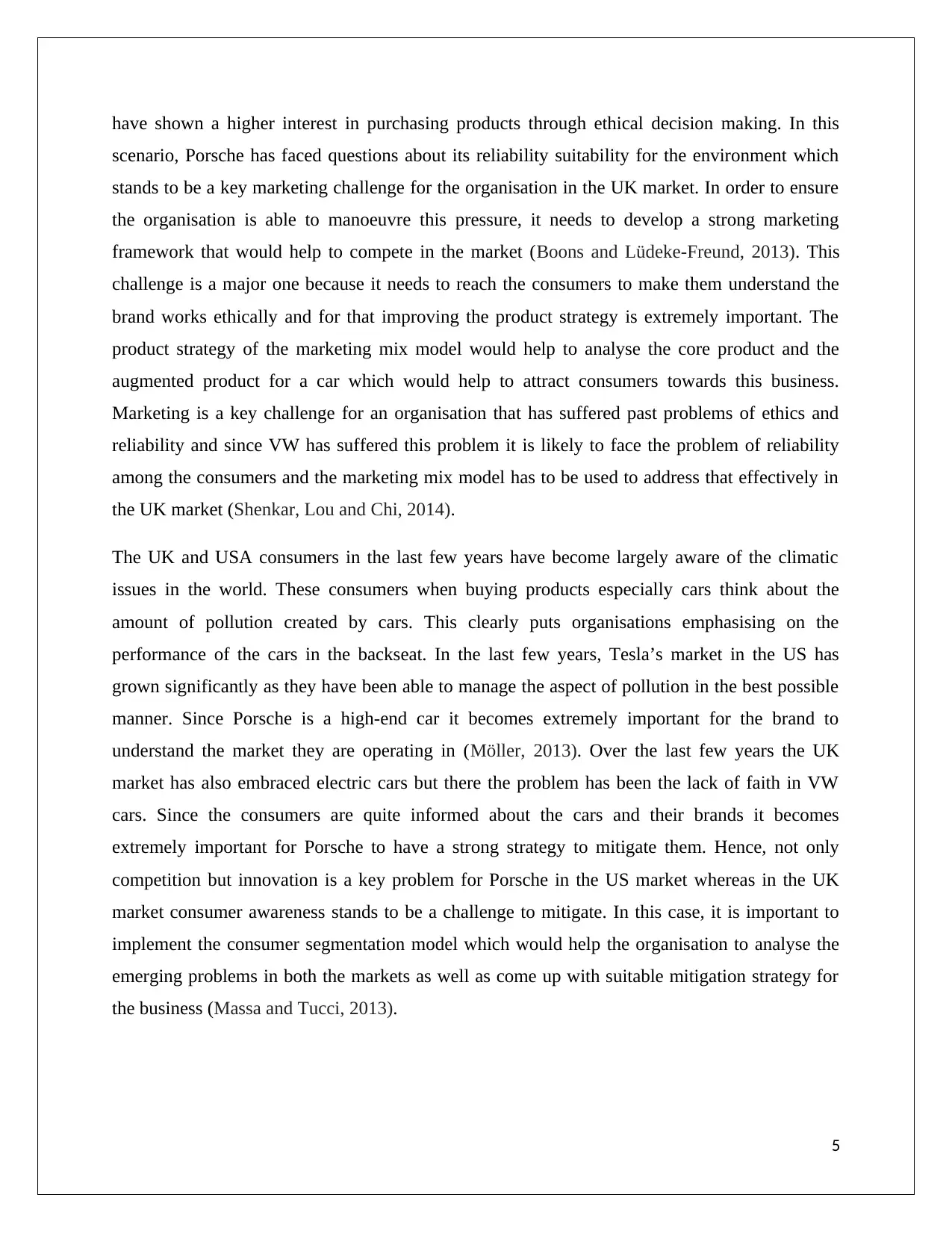
have shown a higher interest in purchasing products through ethical decision making. In this
scenario, Porsche has faced questions about its reliability suitability for the environment which
stands to be a key marketing challenge for the organisation in the UK market. In order to ensure
the organisation is able to manoeuvre this pressure, it needs to develop a strong marketing
framework that would help to compete in the market (Boons and Lüdeke-Freund, 2013). This
challenge is a major one because it needs to reach the consumers to make them understand the
brand works ethically and for that improving the product strategy is extremely important. The
product strategy of the marketing mix model would help to analyse the core product and the
augmented product for a car which would help to attract consumers towards this business.
Marketing is a key challenge for an organisation that has suffered past problems of ethics and
reliability and since VW has suffered this problem it is likely to face the problem of reliability
among the consumers and the marketing mix model has to be used to address that effectively in
the UK market (Shenkar, Lou and Chi, 2014).
The UK and USA consumers in the last few years have become largely aware of the climatic
issues in the world. These consumers when buying products especially cars think about the
amount of pollution created by cars. This clearly puts organisations emphasising on the
performance of the cars in the backseat. In the last few years, Tesla’s market in the US has
grown significantly as they have been able to manage the aspect of pollution in the best possible
manner. Since Porsche is a high-end car it becomes extremely important for the brand to
understand the market they are operating in (Möller, 2013). Over the last few years the UK
market has also embraced electric cars but there the problem has been the lack of faith in VW
cars. Since the consumers are quite informed about the cars and their brands it becomes
extremely important for Porsche to have a strong strategy to mitigate them. Hence, not only
competition but innovation is a key problem for Porsche in the US market whereas in the UK
market consumer awareness stands to be a challenge to mitigate. In this case, it is important to
implement the consumer segmentation model which would help the organisation to analyse the
emerging problems in both the markets as well as come up with suitable mitigation strategy for
the business (Massa and Tucci, 2013).
5
scenario, Porsche has faced questions about its reliability suitability for the environment which
stands to be a key marketing challenge for the organisation in the UK market. In order to ensure
the organisation is able to manoeuvre this pressure, it needs to develop a strong marketing
framework that would help to compete in the market (Boons and Lüdeke-Freund, 2013). This
challenge is a major one because it needs to reach the consumers to make them understand the
brand works ethically and for that improving the product strategy is extremely important. The
product strategy of the marketing mix model would help to analyse the core product and the
augmented product for a car which would help to attract consumers towards this business.
Marketing is a key challenge for an organisation that has suffered past problems of ethics and
reliability and since VW has suffered this problem it is likely to face the problem of reliability
among the consumers and the marketing mix model has to be used to address that effectively in
the UK market (Shenkar, Lou and Chi, 2014).
The UK and USA consumers in the last few years have become largely aware of the climatic
issues in the world. These consumers when buying products especially cars think about the
amount of pollution created by cars. This clearly puts organisations emphasising on the
performance of the cars in the backseat. In the last few years, Tesla’s market in the US has
grown significantly as they have been able to manage the aspect of pollution in the best possible
manner. Since Porsche is a high-end car it becomes extremely important for the brand to
understand the market they are operating in (Möller, 2013). Over the last few years the UK
market has also embraced electric cars but there the problem has been the lack of faith in VW
cars. Since the consumers are quite informed about the cars and their brands it becomes
extremely important for Porsche to have a strong strategy to mitigate them. Hence, not only
competition but innovation is a key problem for Porsche in the US market whereas in the UK
market consumer awareness stands to be a challenge to mitigate. In this case, it is important to
implement the consumer segmentation model which would help the organisation to analyse the
emerging problems in both the markets as well as come up with suitable mitigation strategy for
the business (Massa and Tucci, 2013).
5
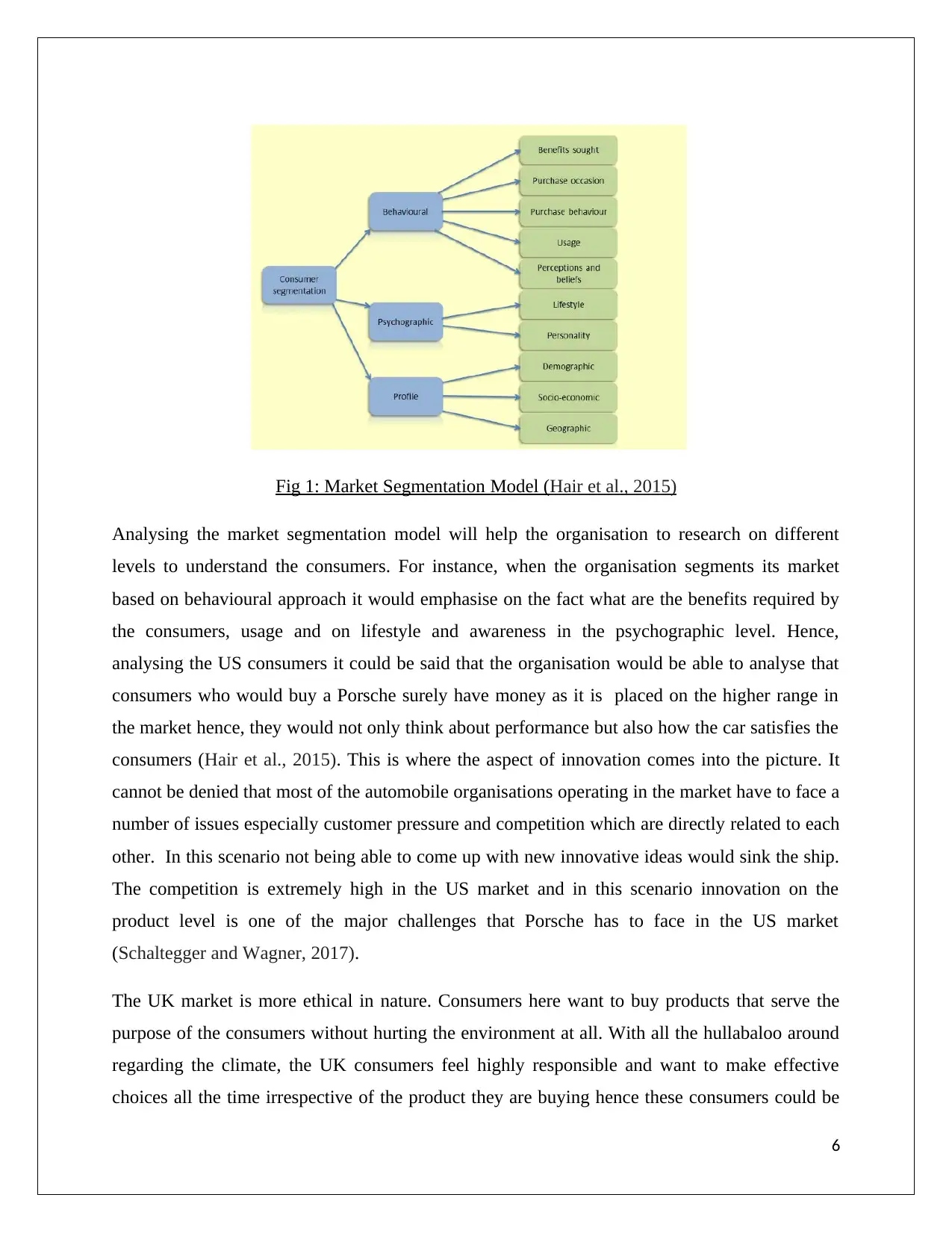
Fig 1: Market Segmentation Model (Hair et al., 2015)
Analysing the market segmentation model will help the organisation to research on different
levels to understand the consumers. For instance, when the organisation segments its market
based on behavioural approach it would emphasise on the fact what are the benefits required by
the consumers, usage and on lifestyle and awareness in the psychographic level. Hence,
analysing the US consumers it could be said that the organisation would be able to analyse that
consumers who would buy a Porsche surely have money as it is placed on the higher range in
the market hence, they would not only think about performance but also how the car satisfies the
consumers (Hair et al., 2015). This is where the aspect of innovation comes into the picture. It
cannot be denied that most of the automobile organisations operating in the market have to face a
number of issues especially customer pressure and competition which are directly related to each
other. In this scenario not being able to come up with new innovative ideas would sink the ship.
The competition is extremely high in the US market and in this scenario innovation on the
product level is one of the major challenges that Porsche has to face in the US market
(Schaltegger and Wagner, 2017).
The UK market is more ethical in nature. Consumers here want to buy products that serve the
purpose of the consumers without hurting the environment at all. With all the hullabaloo around
regarding the climate, the UK consumers feel highly responsible and want to make effective
choices all the time irrespective of the product they are buying hence these consumers could be
6
Analysing the market segmentation model will help the organisation to research on different
levels to understand the consumers. For instance, when the organisation segments its market
based on behavioural approach it would emphasise on the fact what are the benefits required by
the consumers, usage and on lifestyle and awareness in the psychographic level. Hence,
analysing the US consumers it could be said that the organisation would be able to analyse that
consumers who would buy a Porsche surely have money as it is placed on the higher range in
the market hence, they would not only think about performance but also how the car satisfies the
consumers (Hair et al., 2015). This is where the aspect of innovation comes into the picture. It
cannot be denied that most of the automobile organisations operating in the market have to face a
number of issues especially customer pressure and competition which are directly related to each
other. In this scenario not being able to come up with new innovative ideas would sink the ship.
The competition is extremely high in the US market and in this scenario innovation on the
product level is one of the major challenges that Porsche has to face in the US market
(Schaltegger and Wagner, 2017).
The UK market is more ethical in nature. Consumers here want to buy products that serve the
purpose of the consumers without hurting the environment at all. With all the hullabaloo around
regarding the climate, the UK consumers feel highly responsible and want to make effective
choices all the time irrespective of the product they are buying hence these consumers could be
6
⊘ This is a preview!⊘
Do you want full access?
Subscribe today to unlock all pages.

Trusted by 1+ million students worldwide
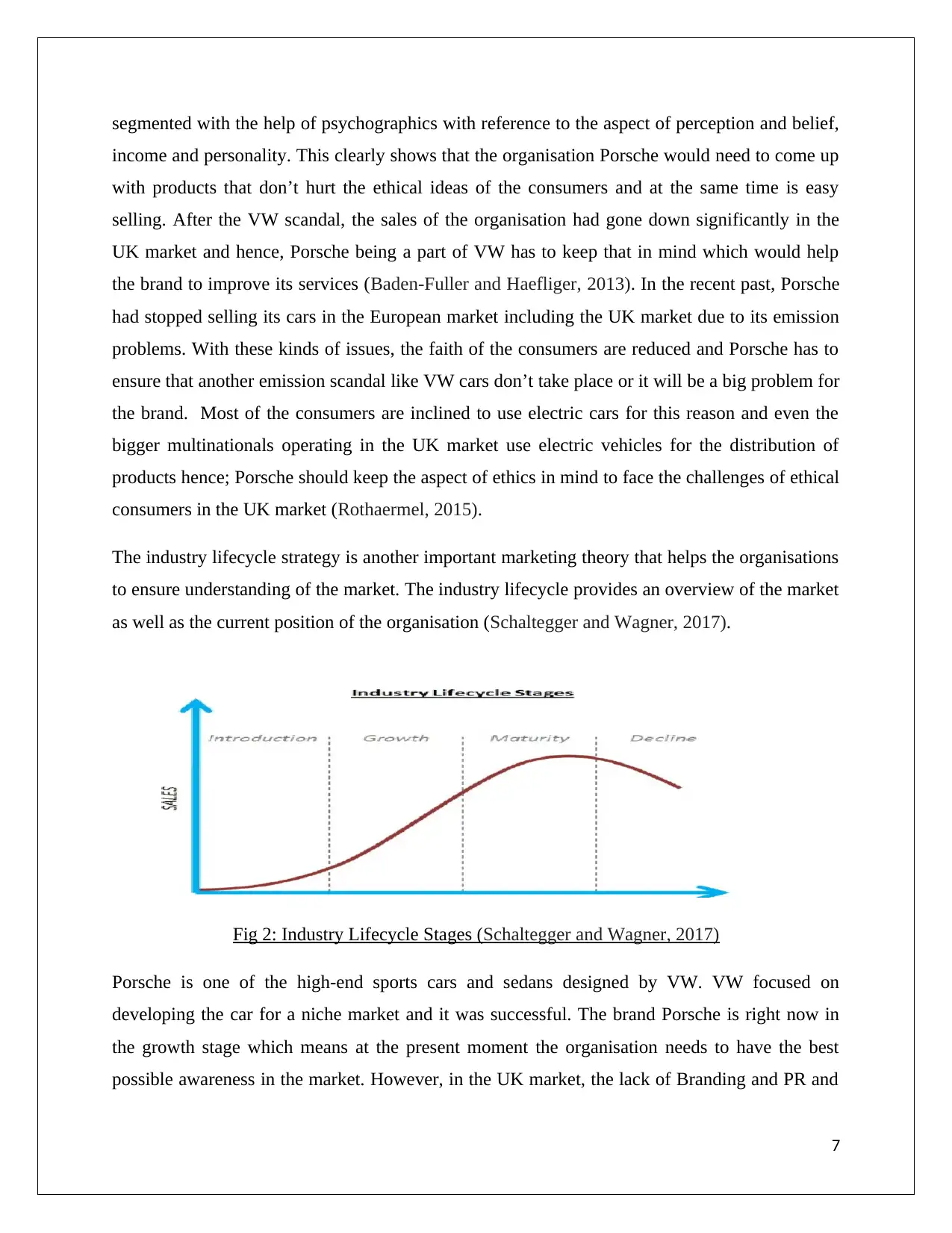
segmented with the help of psychographics with reference to the aspect of perception and belief,
income and personality. This clearly shows that the organisation Porsche would need to come up
with products that don’t hurt the ethical ideas of the consumers and at the same time is easy
selling. After the VW scandal, the sales of the organisation had gone down significantly in the
UK market and hence, Porsche being a part of VW has to keep that in mind which would help
the brand to improve its services (Baden-Fuller and Haefliger, 2013). In the recent past, Porsche
had stopped selling its cars in the European market including the UK market due to its emission
problems. With these kinds of issues, the faith of the consumers are reduced and Porsche has to
ensure that another emission scandal like VW cars don’t take place or it will be a big problem for
the brand. Most of the consumers are inclined to use electric cars for this reason and even the
bigger multinationals operating in the UK market use electric vehicles for the distribution of
products hence; Porsche should keep the aspect of ethics in mind to face the challenges of ethical
consumers in the UK market (Rothaermel, 2015).
The industry lifecycle strategy is another important marketing theory that helps the organisations
to ensure understanding of the market. The industry lifecycle provides an overview of the market
as well as the current position of the organisation (Schaltegger and Wagner, 2017).
Fig 2: Industry Lifecycle Stages (Schaltegger and Wagner, 2017)
Porsche is one of the high-end sports cars and sedans designed by VW. VW focused on
developing the car for a niche market and it was successful. The brand Porsche is right now in
the growth stage which means at the present moment the organisation needs to have the best
possible awareness in the market. However, in the UK market, the lack of Branding and PR and
7
income and personality. This clearly shows that the organisation Porsche would need to come up
with products that don’t hurt the ethical ideas of the consumers and at the same time is easy
selling. After the VW scandal, the sales of the organisation had gone down significantly in the
UK market and hence, Porsche being a part of VW has to keep that in mind which would help
the brand to improve its services (Baden-Fuller and Haefliger, 2013). In the recent past, Porsche
had stopped selling its cars in the European market including the UK market due to its emission
problems. With these kinds of issues, the faith of the consumers are reduced and Porsche has to
ensure that another emission scandal like VW cars don’t take place or it will be a big problem for
the brand. Most of the consumers are inclined to use electric cars for this reason and even the
bigger multinationals operating in the UK market use electric vehicles for the distribution of
products hence; Porsche should keep the aspect of ethics in mind to face the challenges of ethical
consumers in the UK market (Rothaermel, 2015).
The industry lifecycle strategy is another important marketing theory that helps the organisations
to ensure understanding of the market. The industry lifecycle provides an overview of the market
as well as the current position of the organisation (Schaltegger and Wagner, 2017).
Fig 2: Industry Lifecycle Stages (Schaltegger and Wagner, 2017)
Porsche is one of the high-end sports cars and sedans designed by VW. VW focused on
developing the car for a niche market and it was successful. The brand Porsche is right now in
the growth stage which means at the present moment the organisation needs to have the best
possible awareness in the market. However, in the UK market, the lack of Branding and PR and
7
Paraphrase This Document
Need a fresh take? Get an instant paraphrase of this document with our AI Paraphraser
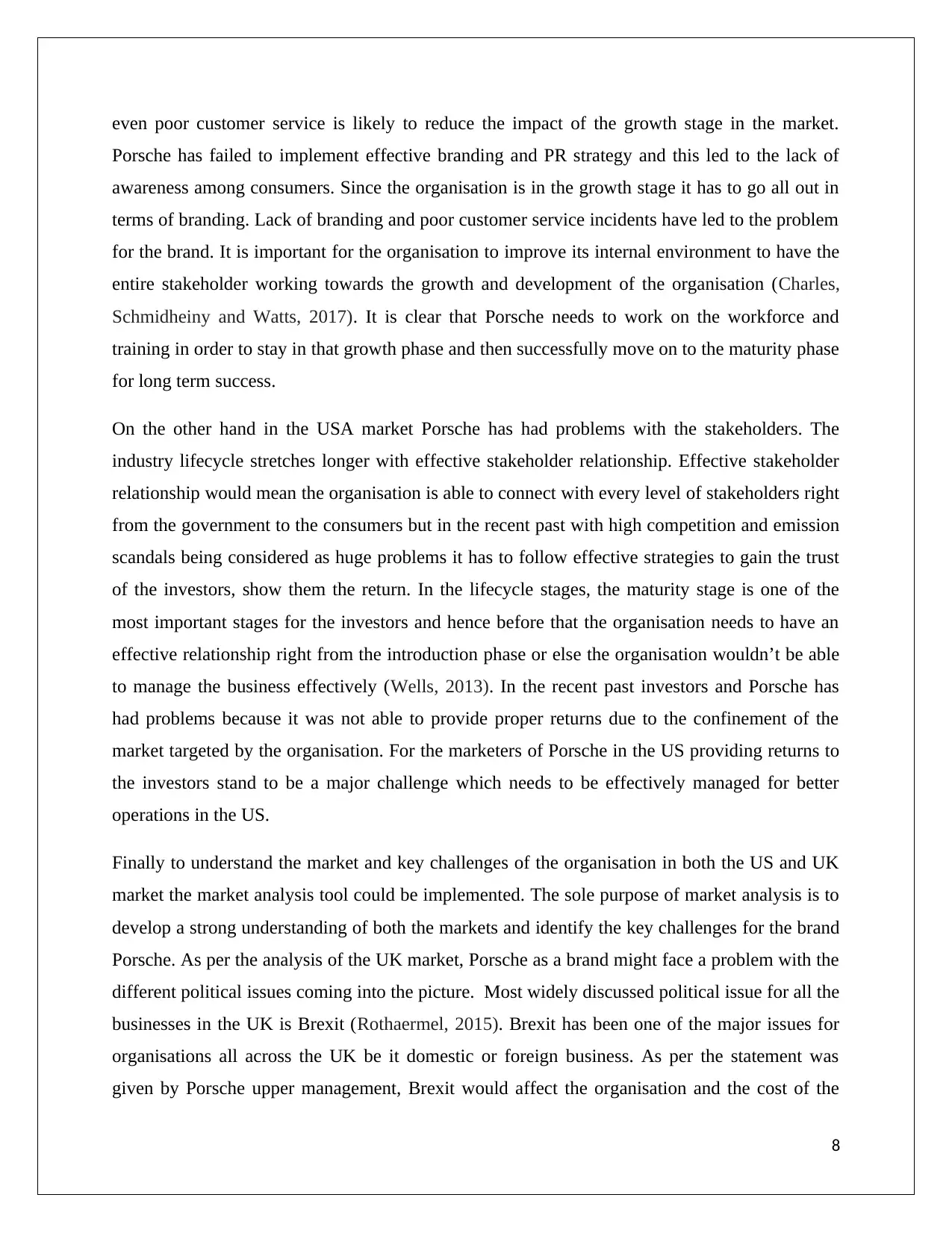
even poor customer service is likely to reduce the impact of the growth stage in the market.
Porsche has failed to implement effective branding and PR strategy and this led to the lack of
awareness among consumers. Since the organisation is in the growth stage it has to go all out in
terms of branding. Lack of branding and poor customer service incidents have led to the problem
for the brand. It is important for the organisation to improve its internal environment to have the
entire stakeholder working towards the growth and development of the organisation (Charles,
Schmidheiny and Watts, 2017). It is clear that Porsche needs to work on the workforce and
training in order to stay in that growth phase and then successfully move on to the maturity phase
for long term success.
On the other hand in the USA market Porsche has had problems with the stakeholders. The
industry lifecycle stretches longer with effective stakeholder relationship. Effective stakeholder
relationship would mean the organisation is able to connect with every level of stakeholders right
from the government to the consumers but in the recent past with high competition and emission
scandals being considered as huge problems it has to follow effective strategies to gain the trust
of the investors, show them the return. In the lifecycle stages, the maturity stage is one of the
most important stages for the investors and hence before that the organisation needs to have an
effective relationship right from the introduction phase or else the organisation wouldn’t be able
to manage the business effectively (Wells, 2013). In the recent past investors and Porsche has
had problems because it was not able to provide proper returns due to the confinement of the
market targeted by the organisation. For the marketers of Porsche in the US providing returns to
the investors stand to be a major challenge which needs to be effectively managed for better
operations in the US.
Finally to understand the market and key challenges of the organisation in both the US and UK
market the market analysis tool could be implemented. The sole purpose of market analysis is to
develop a strong understanding of both the markets and identify the key challenges for the brand
Porsche. As per the analysis of the UK market, Porsche as a brand might face a problem with the
different political issues coming into the picture. Most widely discussed political issue for all the
businesses in the UK is Brexit (Rothaermel, 2015). Brexit has been one of the major issues for
organisations all across the UK be it domestic or foreign business. As per the statement was
given by Porsche upper management, Brexit would affect the organisation and the cost of the
8
Porsche has failed to implement effective branding and PR strategy and this led to the lack of
awareness among consumers. Since the organisation is in the growth stage it has to go all out in
terms of branding. Lack of branding and poor customer service incidents have led to the problem
for the brand. It is important for the organisation to improve its internal environment to have the
entire stakeholder working towards the growth and development of the organisation (Charles,
Schmidheiny and Watts, 2017). It is clear that Porsche needs to work on the workforce and
training in order to stay in that growth phase and then successfully move on to the maturity phase
for long term success.
On the other hand in the USA market Porsche has had problems with the stakeholders. The
industry lifecycle stretches longer with effective stakeholder relationship. Effective stakeholder
relationship would mean the organisation is able to connect with every level of stakeholders right
from the government to the consumers but in the recent past with high competition and emission
scandals being considered as huge problems it has to follow effective strategies to gain the trust
of the investors, show them the return. In the lifecycle stages, the maturity stage is one of the
most important stages for the investors and hence before that the organisation needs to have an
effective relationship right from the introduction phase or else the organisation wouldn’t be able
to manage the business effectively (Wells, 2013). In the recent past investors and Porsche has
had problems because it was not able to provide proper returns due to the confinement of the
market targeted by the organisation. For the marketers of Porsche in the US providing returns to
the investors stand to be a major challenge which needs to be effectively managed for better
operations in the US.
Finally to understand the market and key challenges of the organisation in both the US and UK
market the market analysis tool could be implemented. The sole purpose of market analysis is to
develop a strong understanding of both the markets and identify the key challenges for the brand
Porsche. As per the analysis of the UK market, Porsche as a brand might face a problem with the
different political issues coming into the picture. Most widely discussed political issue for all the
businesses in the UK is Brexit (Rothaermel, 2015). Brexit has been one of the major issues for
organisations all across the UK be it domestic or foreign business. As per the statement was
given by Porsche upper management, Brexit would affect the organisation and the cost of the
8
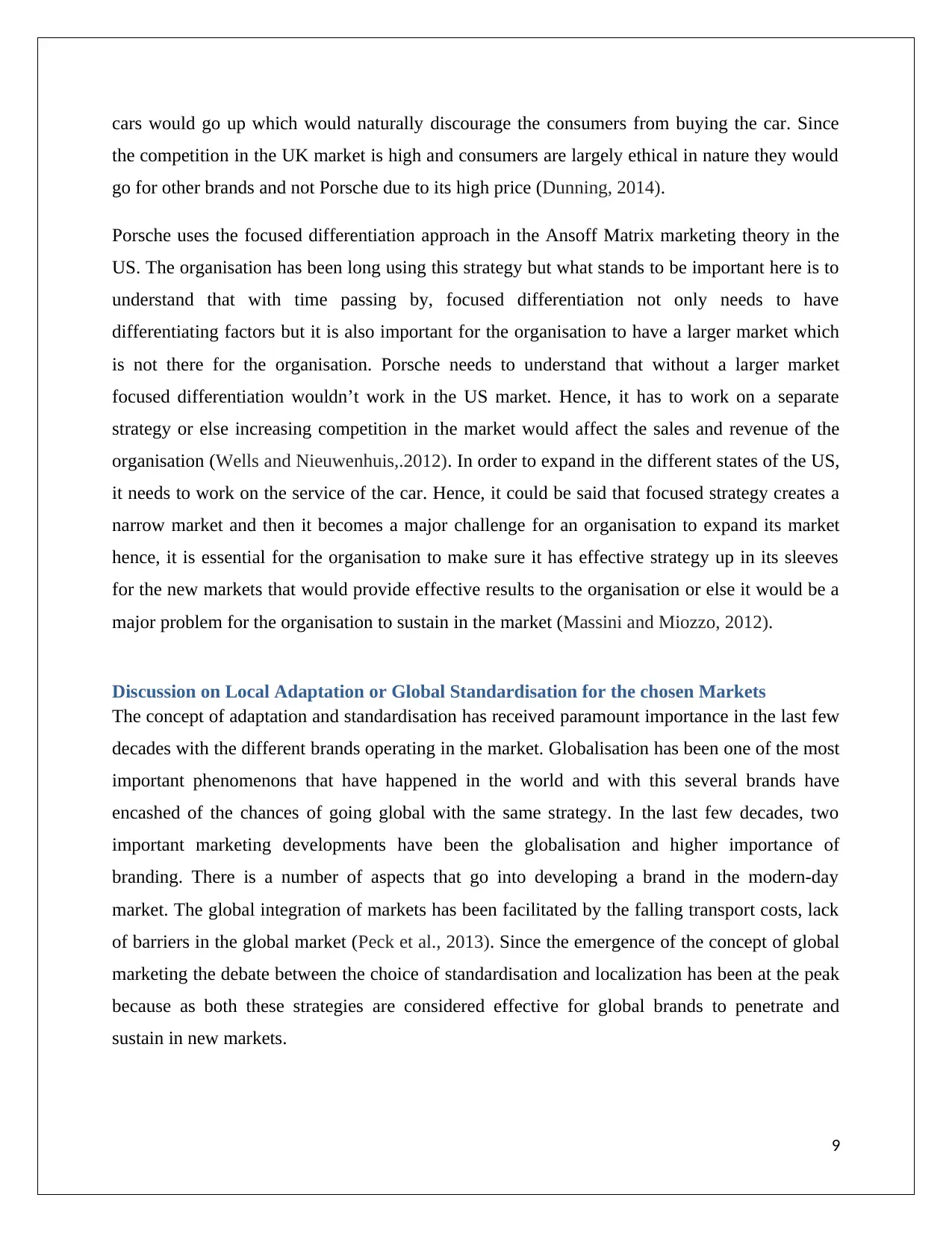
cars would go up which would naturally discourage the consumers from buying the car. Since
the competition in the UK market is high and consumers are largely ethical in nature they would
go for other brands and not Porsche due to its high price (Dunning, 2014).
Porsche uses the focused differentiation approach in the Ansoff Matrix marketing theory in the
US. The organisation has been long using this strategy but what stands to be important here is to
understand that with time passing by, focused differentiation not only needs to have
differentiating factors but it is also important for the organisation to have a larger market which
is not there for the organisation. Porsche needs to understand that without a larger market
focused differentiation wouldn’t work in the US market. Hence, it has to work on a separate
strategy or else increasing competition in the market would affect the sales and revenue of the
organisation (Wells and Nieuwenhuis,.2012). In order to expand in the different states of the US,
it needs to work on the service of the car. Hence, it could be said that focused strategy creates a
narrow market and then it becomes a major challenge for an organisation to expand its market
hence, it is essential for the organisation to make sure it has effective strategy up in its sleeves
for the new markets that would provide effective results to the organisation or else it would be a
major problem for the organisation to sustain in the market (Massini and Miozzo, 2012).
Discussion on Local Adaptation or Global Standardisation for the chosen Markets
The concept of adaptation and standardisation has received paramount importance in the last few
decades with the different brands operating in the market. Globalisation has been one of the most
important phenomenons that have happened in the world and with this several brands have
encashed of the chances of going global with the same strategy. In the last few decades, two
important marketing developments have been the globalisation and higher importance of
branding. There is a number of aspects that go into developing a brand in the modern-day
market. The global integration of markets has been facilitated by the falling transport costs, lack
of barriers in the global market (Peck et al., 2013). Since the emergence of the concept of global
marketing the debate between the choice of standardisation and localization has been at the peak
because as both these strategies are considered effective for global brands to penetrate and
sustain in new markets.
9
the competition in the UK market is high and consumers are largely ethical in nature they would
go for other brands and not Porsche due to its high price (Dunning, 2014).
Porsche uses the focused differentiation approach in the Ansoff Matrix marketing theory in the
US. The organisation has been long using this strategy but what stands to be important here is to
understand that with time passing by, focused differentiation not only needs to have
differentiating factors but it is also important for the organisation to have a larger market which
is not there for the organisation. Porsche needs to understand that without a larger market
focused differentiation wouldn’t work in the US market. Hence, it has to work on a separate
strategy or else increasing competition in the market would affect the sales and revenue of the
organisation (Wells and Nieuwenhuis,.2012). In order to expand in the different states of the US,
it needs to work on the service of the car. Hence, it could be said that focused strategy creates a
narrow market and then it becomes a major challenge for an organisation to expand its market
hence, it is essential for the organisation to make sure it has effective strategy up in its sleeves
for the new markets that would provide effective results to the organisation or else it would be a
major problem for the organisation to sustain in the market (Massini and Miozzo, 2012).
Discussion on Local Adaptation or Global Standardisation for the chosen Markets
The concept of adaptation and standardisation has received paramount importance in the last few
decades with the different brands operating in the market. Globalisation has been one of the most
important phenomenons that have happened in the world and with this several brands have
encashed of the chances of going global with the same strategy. In the last few decades, two
important marketing developments have been the globalisation and higher importance of
branding. There is a number of aspects that go into developing a brand in the modern-day
market. The global integration of markets has been facilitated by the falling transport costs, lack
of barriers in the global market (Peck et al., 2013). Since the emergence of the concept of global
marketing the debate between the choice of standardisation and localization has been at the peak
because as both these strategies are considered effective for global brands to penetrate and
sustain in new markets.
9
⊘ This is a preview!⊘
Do you want full access?
Subscribe today to unlock all pages.

Trusted by 1+ million students worldwide
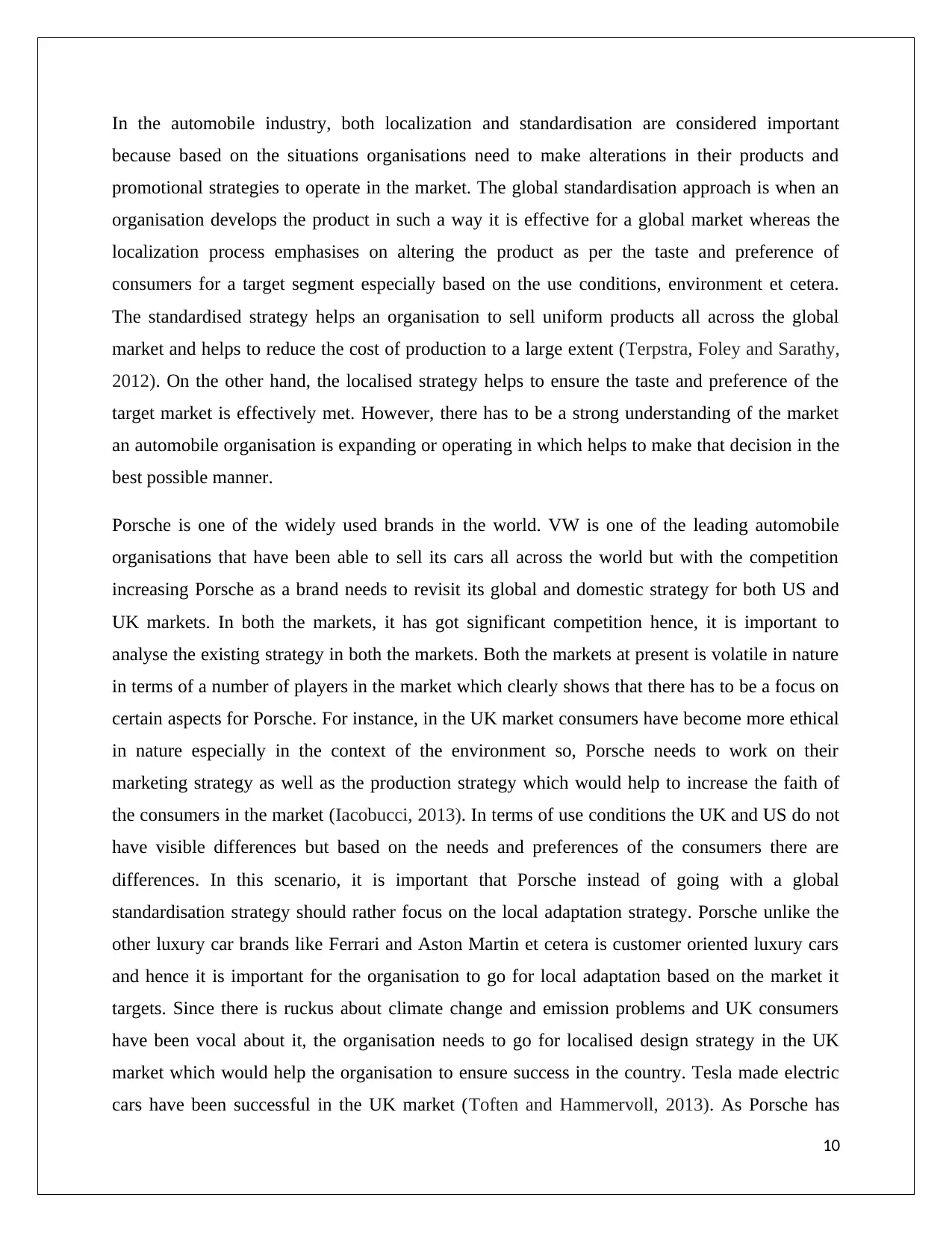
In the automobile industry, both localization and standardisation are considered important
because based on the situations organisations need to make alterations in their products and
promotional strategies to operate in the market. The global standardisation approach is when an
organisation develops the product in such a way it is effective for a global market whereas the
localization process emphasises on altering the product as per the taste and preference of
consumers for a target segment especially based on the use conditions, environment et cetera.
The standardised strategy helps an organisation to sell uniform products all across the global
market and helps to reduce the cost of production to a large extent (Terpstra, Foley and Sarathy,
2012). On the other hand, the localised strategy helps to ensure the taste and preference of the
target market is effectively met. However, there has to be a strong understanding of the market
an automobile organisation is expanding or operating in which helps to make that decision in the
best possible manner.
Porsche is one of the widely used brands in the world. VW is one of the leading automobile
organisations that have been able to sell its cars all across the world but with the competition
increasing Porsche as a brand needs to revisit its global and domestic strategy for both US and
UK markets. In both the markets, it has got significant competition hence, it is important to
analyse the existing strategy in both the markets. Both the markets at present is volatile in nature
in terms of a number of players in the market which clearly shows that there has to be a focus on
certain aspects for Porsche. For instance, in the UK market consumers have become more ethical
in nature especially in the context of the environment so, Porsche needs to work on their
marketing strategy as well as the production strategy which would help to increase the faith of
the consumers in the market (Iacobucci, 2013). In terms of use conditions the UK and US do not
have visible differences but based on the needs and preferences of the consumers there are
differences. In this scenario, it is important that Porsche instead of going with a global
standardisation strategy should rather focus on the local adaptation strategy. Porsche unlike the
other luxury car brands like Ferrari and Aston Martin et cetera is customer oriented luxury cars
and hence it is important for the organisation to go for local adaptation based on the market it
targets. Since there is ruckus about climate change and emission problems and UK consumers
have been vocal about it, the organisation needs to go for localised design strategy in the UK
market which would help the organisation to ensure success in the country. Tesla made electric
cars have been successful in the UK market (Toften and Hammervoll, 2013). As Porsche has
10
because based on the situations organisations need to make alterations in their products and
promotional strategies to operate in the market. The global standardisation approach is when an
organisation develops the product in such a way it is effective for a global market whereas the
localization process emphasises on altering the product as per the taste and preference of
consumers for a target segment especially based on the use conditions, environment et cetera.
The standardised strategy helps an organisation to sell uniform products all across the global
market and helps to reduce the cost of production to a large extent (Terpstra, Foley and Sarathy,
2012). On the other hand, the localised strategy helps to ensure the taste and preference of the
target market is effectively met. However, there has to be a strong understanding of the market
an automobile organisation is expanding or operating in which helps to make that decision in the
best possible manner.
Porsche is one of the widely used brands in the world. VW is one of the leading automobile
organisations that have been able to sell its cars all across the world but with the competition
increasing Porsche as a brand needs to revisit its global and domestic strategy for both US and
UK markets. In both the markets, it has got significant competition hence, it is important to
analyse the existing strategy in both the markets. Both the markets at present is volatile in nature
in terms of a number of players in the market which clearly shows that there has to be a focus on
certain aspects for Porsche. For instance, in the UK market consumers have become more ethical
in nature especially in the context of the environment so, Porsche needs to work on their
marketing strategy as well as the production strategy which would help to increase the faith of
the consumers in the market (Iacobucci, 2013). In terms of use conditions the UK and US do not
have visible differences but based on the needs and preferences of the consumers there are
differences. In this scenario, it is important that Porsche instead of going with a global
standardisation strategy should rather focus on the local adaptation strategy. Porsche unlike the
other luxury car brands like Ferrari and Aston Martin et cetera is customer oriented luxury cars
and hence it is important for the organisation to go for local adaptation based on the market it
targets. Since there is ruckus about climate change and emission problems and UK consumers
have been vocal about it, the organisation needs to go for localised design strategy in the UK
market which would help the organisation to ensure success in the country. Tesla made electric
cars have been successful in the UK market (Toften and Hammervoll, 2013). As Porsche has
10
Paraphrase This Document
Need a fresh take? Get an instant paraphrase of this document with our AI Paraphraser
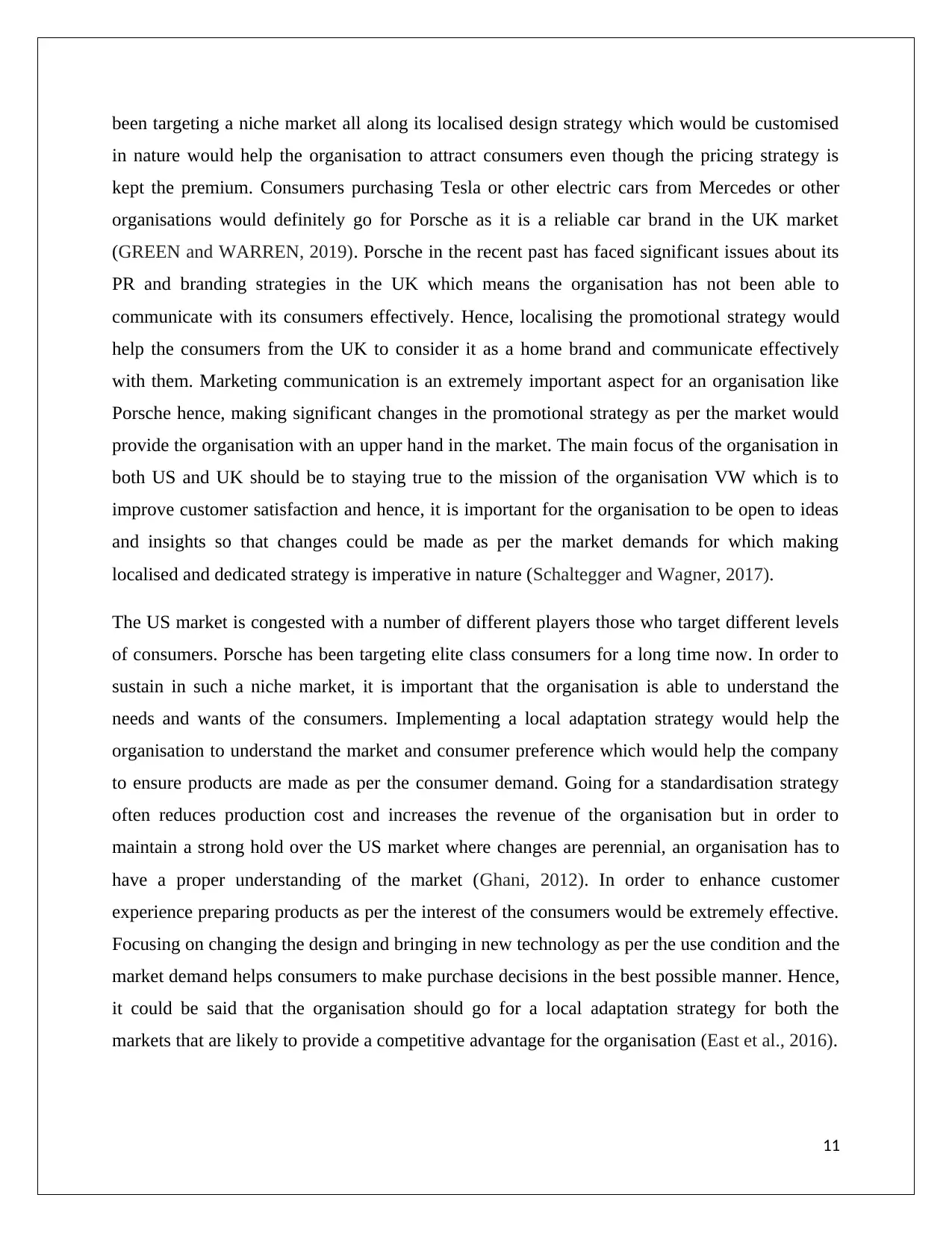
been targeting a niche market all along its localised design strategy which would be customised
in nature would help the organisation to attract consumers even though the pricing strategy is
kept the premium. Consumers purchasing Tesla or other electric cars from Mercedes or other
organisations would definitely go for Porsche as it is a reliable car brand in the UK market
(GREEN and WARREN, 2019). Porsche in the recent past has faced significant issues about its
PR and branding strategies in the UK which means the organisation has not been able to
communicate with its consumers effectively. Hence, localising the promotional strategy would
help the consumers from the UK to consider it as a home brand and communicate effectively
with them. Marketing communication is an extremely important aspect for an organisation like
Porsche hence, making significant changes in the promotional strategy as per the market would
provide the organisation with an upper hand in the market. The main focus of the organisation in
both US and UK should be to staying true to the mission of the organisation VW which is to
improve customer satisfaction and hence, it is important for the organisation to be open to ideas
and insights so that changes could be made as per the market demands for which making
localised and dedicated strategy is imperative in nature (Schaltegger and Wagner, 2017).
The US market is congested with a number of different players those who target different levels
of consumers. Porsche has been targeting elite class consumers for a long time now. In order to
sustain in such a niche market, it is important that the organisation is able to understand the
needs and wants of the consumers. Implementing a local adaptation strategy would help the
organisation to understand the market and consumer preference which would help the company
to ensure products are made as per the consumer demand. Going for a standardisation strategy
often reduces production cost and increases the revenue of the organisation but in order to
maintain a strong hold over the US market where changes are perennial, an organisation has to
have a proper understanding of the market (Ghani, 2012). In order to enhance customer
experience preparing products as per the interest of the consumers would be extremely effective.
Focusing on changing the design and bringing in new technology as per the use condition and the
market demand helps consumers to make purchase decisions in the best possible manner. Hence,
it could be said that the organisation should go for a local adaptation strategy for both the
markets that are likely to provide a competitive advantage for the organisation (East et al., 2016).
11
in nature would help the organisation to attract consumers even though the pricing strategy is
kept the premium. Consumers purchasing Tesla or other electric cars from Mercedes or other
organisations would definitely go for Porsche as it is a reliable car brand in the UK market
(GREEN and WARREN, 2019). Porsche in the recent past has faced significant issues about its
PR and branding strategies in the UK which means the organisation has not been able to
communicate with its consumers effectively. Hence, localising the promotional strategy would
help the consumers from the UK to consider it as a home brand and communicate effectively
with them. Marketing communication is an extremely important aspect for an organisation like
Porsche hence, making significant changes in the promotional strategy as per the market would
provide the organisation with an upper hand in the market. The main focus of the organisation in
both US and UK should be to staying true to the mission of the organisation VW which is to
improve customer satisfaction and hence, it is important for the organisation to be open to ideas
and insights so that changes could be made as per the market demands for which making
localised and dedicated strategy is imperative in nature (Schaltegger and Wagner, 2017).
The US market is congested with a number of different players those who target different levels
of consumers. Porsche has been targeting elite class consumers for a long time now. In order to
sustain in such a niche market, it is important that the organisation is able to understand the
needs and wants of the consumers. Implementing a local adaptation strategy would help the
organisation to understand the market and consumer preference which would help the company
to ensure products are made as per the consumer demand. Going for a standardisation strategy
often reduces production cost and increases the revenue of the organisation but in order to
maintain a strong hold over the US market where changes are perennial, an organisation has to
have a proper understanding of the market (Ghani, 2012). In order to enhance customer
experience preparing products as per the interest of the consumers would be extremely effective.
Focusing on changing the design and bringing in new technology as per the use condition and the
market demand helps consumers to make purchase decisions in the best possible manner. Hence,
it could be said that the organisation should go for a local adaptation strategy for both the
markets that are likely to provide a competitive advantage for the organisation (East et al., 2016).
11
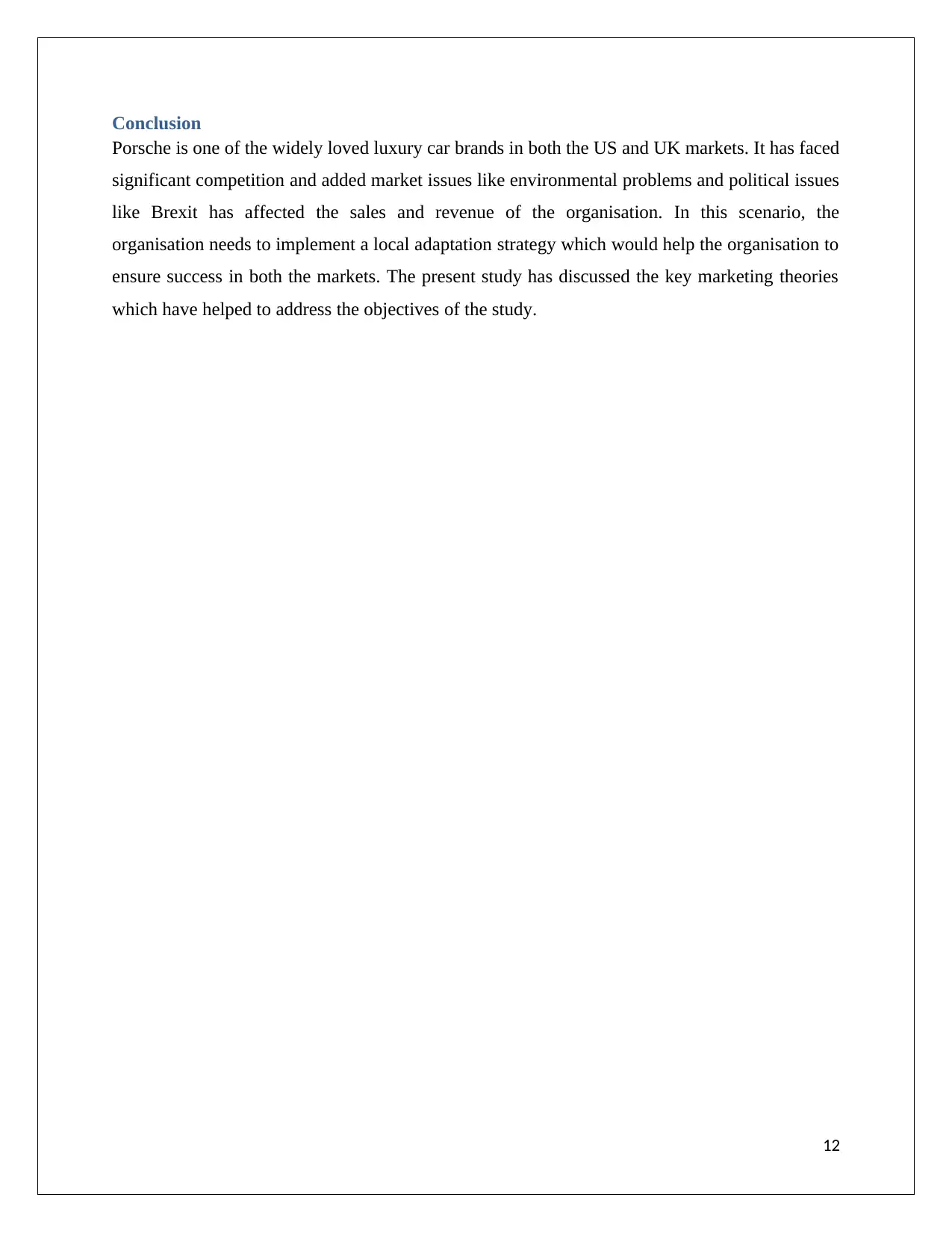
Conclusion
Porsche is one of the widely loved luxury car brands in both the US and UK markets. It has faced
significant competition and added market issues like environmental problems and political issues
like Brexit has affected the sales and revenue of the organisation. In this scenario, the
organisation needs to implement a local adaptation strategy which would help the organisation to
ensure success in both the markets. The present study has discussed the key marketing theories
which have helped to address the objectives of the study.
12
Porsche is one of the widely loved luxury car brands in both the US and UK markets. It has faced
significant competition and added market issues like environmental problems and political issues
like Brexit has affected the sales and revenue of the organisation. In this scenario, the
organisation needs to implement a local adaptation strategy which would help the organisation to
ensure success in both the markets. The present study has discussed the key marketing theories
which have helped to address the objectives of the study.
12
⊘ This is a preview!⊘
Do you want full access?
Subscribe today to unlock all pages.

Trusted by 1+ million students worldwide
1 out of 15
Related Documents
Your All-in-One AI-Powered Toolkit for Academic Success.
+13062052269
info@desklib.com
Available 24*7 on WhatsApp / Email
![[object Object]](/_next/static/media/star-bottom.7253800d.svg)
Unlock your academic potential
Copyright © 2020–2025 A2Z Services. All Rights Reserved. Developed and managed by ZUCOL.




